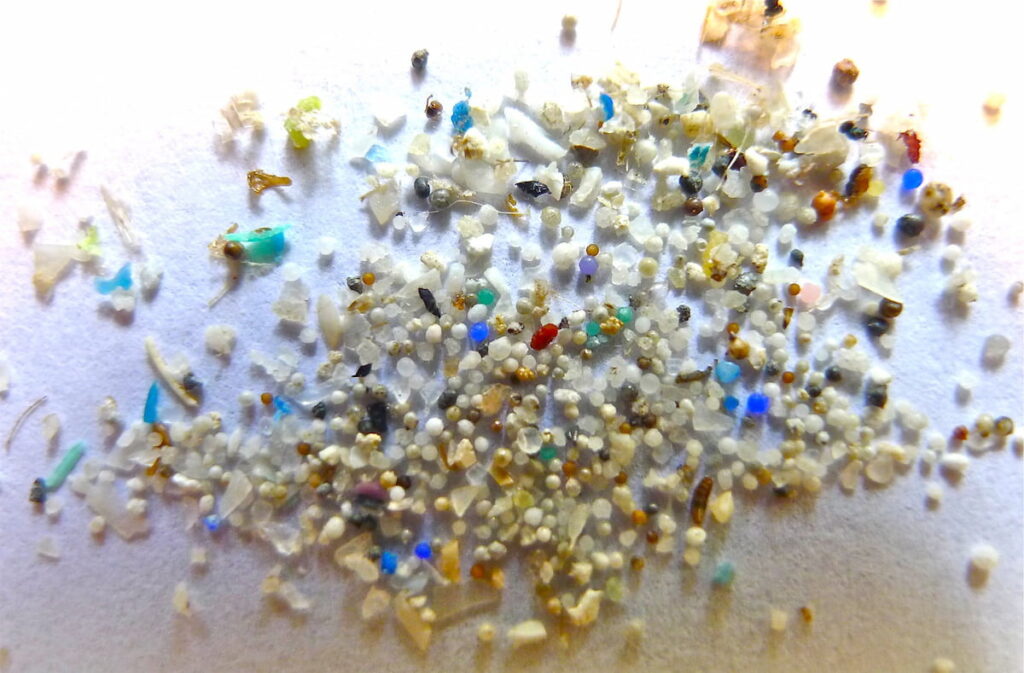What are Microplastics and Microfibers?
Breaking down these mega-issues for our ocean and planet

You’ve probably seen a lot of headlines in the news about microplastics and all the wild places that scientists have found them—from the top of Mt. Everest to the bottom of the Mariana Trench, to inside our own bodies. But what are microplastics, really?
What are microplastics?
As the name suggests, they are incredibly small—from smaller than a lentil all the way down to 1/100th of the diameter of a human hair. But despite their small size, they present a huge problem. Microplastics have now been found everywhere from the beaches of remote islands to the shores of coastal cities, from the deepest ocean trenches to floating at the water’s surface, and from tropical waters to Arctic sea ice.
Get Ocean Updates in Your Inbox
Sign up with your email and never miss an update.
When it comes to understanding microplastics, there are not only many different sizes but also many different shapes, including fragments, pellets, beads, films, fibers and particles.
Microplastics fall into two main categories: primary and secondary. Primary microplastics are intentionally manufactured, like glitter, plastic beads or the tiny polystyrene balls used to fill bean bags. Secondary microplastics, on the other hand, were previously part of a larger plastic item but have broken off into smaller pieces, such as tiny pieces of food wrappers, milk jugs, paint or tires.
What are microfibers?
In samples taken from the environment, including sediments, fresh water, seawater and even ocean animals, the single most common type of microplastics we encounter are microfibers.
Microfibers are tiny thread-like pieces that shed from our clothes or other textiles as we produce, wash and wear them. You’ve probably seen microfibers without even recognizing them—the little fibers that pill or shed from your favorite fleece jacket and the lint that comes out of our dryers are microfibers.
Given how much is coming out of our dryers, it probably won’t surprise you to hear that a lot of these microfibers are also released in our washing machines. A single load of laundry can release up to 18 million microfibers! In the last 60 years, 5.6 million metric tons of synthetic fibers have been released from clothes washing—that’s equivalent to 28.2 billion T-shirts entering the environment.Microfibers are a growing environmental challenge because our clothes are increasingly made from plastics—synthetic fibers like polyester or nylon make up about 69% of the materials used in textiles, and that number is only expected to grow.
Watch our Instagram Live: “Breaking Down the Massive Problem of Microfibers and Microplastics”.
How do microplastics impact ocean and human health?
While the scientific community is still piecing together the full story of what the presence of these microplastics means for the health of the ocean, wildlife and humans, studies show that plastic can impact ocean animals in many different ways, from impaired growth to impacted reproduction, decreased feeding, weight loss, energy depletion and damage to cells and DNA.
In humans, scientists have also found microplastics just about everywhere they’ve looked from our blood to our lungs and even to our reproductive systems. We also know now that we’re not just talking about one or two errant microplastics making it into our bodies. In fact, Ocean Conservancy recently published a paper that found that in the United States, adults may be consuming up to 3.8 million microplastics each year just from the proteins we eat! We also found microplastics in every single type of the 16 protein types we studied, from seafood like fish and shellfish, to meats like beef, pork and chicken and even plant-based proteins like tofu. And even in these foods, the majority of plastic pieces we identified were microfibers.
Microfibers are especially worrisome because of their unique shapes and sizes. Because they’re so small and thin, these microfibers can make their way further into our bodies. In addition to being the most common type of microplastic we see in the environment and our ocean, microfibers are also the most common microplastic encountered in tissue samples—both in humans and wildlife.
What can we do about microplastics?
Because they are so small and mobile, once microplastics enter the environment, it’s all but impossible to remove or clean them up on a broad scale. That’s why preventing plastic microfibers at the source before they make their way into the environment is so important.
Fortunately, there are many effective, evidence-based methods for preventing microplastics from becoming pollution. The single most effective way to reduce the amount of microplastics that end up in the environment is to make less plastic in the first place. If we have fewer plastics, there will be less microplastic.

Additionally, there are several policies that would help prevent certain kinds of microplastic pollution by targeting some of the biggest sources: textiles and tires. Countries around the world are considering creating durability standards to limit how much materials like textiles or tires are allowed to shed over time. Not only would that decrease microplastic pollution, it would also mean your clothes and tires would last longer—a win-win!
Another method to prevent this kind of pollution is by installing microfiber filters in washing machines. These filters act like lint filters in your dryer to catch microfibers and they’re incredibly effective—some capture 90% of microfibers! That’s millions and millions of microfibers captured each time you wash your clothes.
Ocean Conservancy works diligently on passing laws around the country to prevent microfibers by requiring filters on washing machines. In fact, we developed a whole toolkit to help legislators and advocates pass these types of laws to tackle the most pervasive type of microplastic in our ocean. We all have a part to play in the microplastic pollution problem, and, together, we can make big changes for our country, our planet and our future. If you want to learn more about how you can get involved, head to OceanConservancy.org/Action to join us.